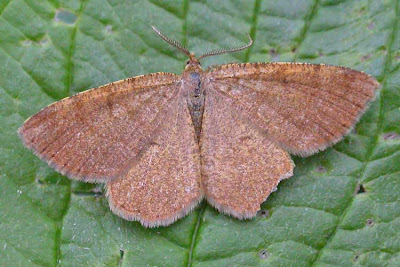I hadn't noticed, until I looked at this photograph, that one of the hind wings looks as if it's been nibbled a bit. A shame because other wise it was almost a perfect specimen, considering that it probably made it across the Channel. It is quite Butterfly like, sometimes sitting with its wings folded vertically, and it is about the same size as a Small Blue, with a wing span of just over an inch.
The Ghost moth is much larger and I saw it flying over the grass as it got dark. The name comes from the white male, the female is yellow, with orange markings. The Ghost is in the family of swifts, and they are among the most primitive moths with no mouth parts in the adults, so they don't feed and very short antennae. The larvae feed on the roots of grasses.
 The Coronet ( Craniophora ligustri)
The Coronet ( Craniophora ligustri)The larvae of the Coronet feed on Ash, which is why I catch quite a few in our garden. The photo brings out the pattern which is quite obscure in some lights.
 Small Clouded Brindle ( Apamea unanimis)
Small Clouded Brindle ( Apamea unanimis)The books say the habitat favoured by the Small Clouded Brindle is damp woodland and grasslands, the larvae feeding on grasses such as Reed Canary-grass and Wavy Hair-grass. I suppose we do have a boggy bit of garden, but I catch a few of these each year.
 Crambus lathoniellus
Crambus lathoniellusThis little micro is one of the Grass moth group. I always think that they look really strange in close up with the large eyes and long palps at the front. At about 1cm long it looks like a minature shrimp at the head end.
The Meal Moth is normally found in barns where grain is stored. It often sits with its abdomen bent up AT 90 deg. as in the photo above.
 It is a widespread moth but the larvae are pests in grain stores and can cause damage if not controlled.
It is a widespread moth but the larvae are pests in grain stores and can cause damage if not controlled.




1 comment:
All fascinating little beasties Tony!
Post a Comment